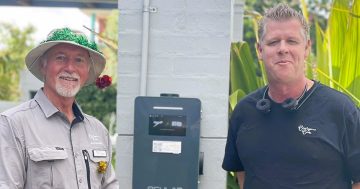
The charger has been installed along Eastlake Parade in Kingston. Photo: James Coleman.
A special kind of streetlight pole has been installed along the Kingston Foreshore as part of a trial to see how the city’s existing electrical infrastructure could be used to provide charging solutions for electric vehicles.
The grey-coloured pole, located next to a 2-hour parallel parking space on Eastlake Parade (soon to be designated for ‘EVs only’), is fitted with a charging box connected to its internal wiring.
Over the next six months, the ACT Government will monitor how it is used to see if streetlight EV chargers could be rolled out across the city.
“It is a convenient option for motorists and a great way to increase EV charging options without the need for additional infrastructure,” Minister for City Services Tara Cheyne said.
It echoes a similar trial held over four weeks in May this year by the NSW Government and Essential Energy in Port Macquarie.
“Differing from other EV charging alternatives, the trial prototype connects to existing electricity used to power the streetlight,” Essential Energy said of the technology.
“This eliminates the need to install additional infrastructure and undergo earthworks, reducing the visual and environmental impact.
“Due to their convenient location near the curb adjacent to car parking spaces, streetlights have the potential to play a significant role in expanding public 24/7, top-up charging facilities in well-lit areas.”

The parking space next to the box will be designated ‘EV only’ in the coming days. Photo: James Coleman.
Charging EVs from power poles and streetlights is nothing new. Overseas, there are thousands installed in London, Los Angeles, Hamburg and more.
Minister for Water, Energy and Emissions Reduction Shane Rattenbury added that while Canberra may not have as much above-ground infrastructure as many other cities, it’s not an opportunity to be passed by.
“Certainly, there are parts of the city, particularly around the town centres, where streetlight-pole charging can potentially be a really effective addition to our network, and we look forward to the results of this trial.”
As the charger is part of a trial, EV owners won’t need to pay to use it. All you need is a normal EV charging adaptor cable.
An ACT Government spokesperson told Region the trial will provide answers on “power draw from the local electrical network, the need for a supply of electricity to streetlight poles (noting that many existing streetlight poles are not supplied with electricity during the day), and implications for electricity retailer requirements”.
Meanwhile, Evie Networks has opened new banks of much faster DC chargers in Calwell, Curtin, Jamison Plaza, Braddon and Hobart Place in the city as 2025 – the ACT Government’s target date for having a total of 180 public chargers installed across the city – draws closer.
This brings the total number of public chargers across the ACT to 170 – up from 29 in 2020 – with 220-odd parking bays attached to them.
“It’s all about making sure that Canberrans have access to charging infrastructure when they need it,” Mr Rattenbury said.
“Most people charge at home, but for travellers, for people who live in apartments, or if you just get caught a bit short, we’re committed to making sure that there is charging infrastructure available for you.”
The government undertook a study in 2022 to identify the parts of the city where public charging facilities were most in demand.
The results became clear earlier this year when $626,275 of funding was split between ActewAGL, BP, ENGIE and Evie Network to install three new chargers in Belconnen, four in North Canberra, eight in Civic, three in Weston Creek and Molonglo, 18 in South Canberra and three in the Woden Valley.
These were described as places “they are needed most, near tourist hotspots, shopping centres and high-residential areas”.

Evie Networks received a slice of $626,275 of funding from the ACT Government to install the new chargers. Photo: James Coleman.
In their bid to win the ACT election in October, the ACT Greens announced a policy to reach net-zero emissions by 2040, five years sooner than the current ACT Government target.
Mr Rattenbury said this would require the installation of an additional 800 to 1000 chargers “by the middle of the next decade”.
“Clearly, we need to examine the electricity infrastructure and make sure there is a good supply,” he added.
“That’s been a matter of working with the suppliers such as Evie and ActewAGL and Evoenergy to work collaboratively to make the best use of the electricity network and its availability.”

The ACT Greens argue public car parks with solar panels on the roof could ease the burden on the electrical grid. Photo: James Coleman.
An ACT Government spokesperson added that power draw from the electrical network is a “critical element that will need to be considered to determine the viability” of a larger roll-out of the streetlight chargers.
Another ACT Greens policy suggests installing solar panels across all ACT Government buildings to generate at least 7 MW of power, or enough to power 4000 homes.
“We also want to look at … a proposal to do solar car parks,” Mr Rattenbury said.
“It’s a really effective way to soak up the sun’s rays, charge people’s cars up, and provide that steady, slow supply of charge for people while they’re at work.”




















